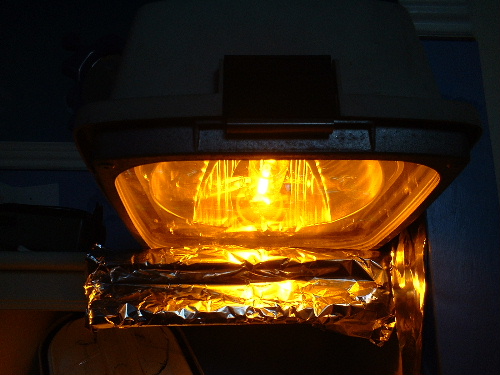
Philips SGS 204
In 2002, Derby saw the commencement of a major road improvement scheme. Called 'Connecting Derby', the scheme involved the altering of a number of roads around the City Centre. As part of this work, some street lighting units were replaced in their entirety. I managed to organise the acquisition of a Thorn Alpha 3 that had been removed from service, or at least, this is what I thought I had secured - upon hearing that a lantern had been removed for me on Thursday 26th September 2002, I visited the site cabin and enquired as to whether a lantern had indeed been saved, as requested. After a rather lengthy discussion between several bewildered workmen, I was eventually shown into a cabin and the SGS 204 was on the floor - not the Alpha 3! Still, beggars cannot be choosers, and I duly carried the lantern out of the cabin and out of the compound, much to the bemusement of people standing nearby at the time!
At 811 mm (2′8″) in length and 383 mm (1′3″) in width, this is a rather bulky lantern; it is also rather heavy, owing to the internal 400 Watt control gear - the weight of the complete lantern being 11 kg (24.2 lb). The resemblance to the smaller SGS 203 lantern is highly apparent. A toughened flat glass cover seals the lamp area - although a polycarbonate bowl was also an option with this lantern, this was only available with the 250 Watt version; the heat from a 400 Watt lamp being too high for the plastic to tolerate.
The canopy is formed from a single piece of Glass Reinforced Plastic; this is in good condition, owing to the relatively short time that the lantern spent in service.
Unlike the SGS 203, where the whole canopy lifts up in order to allow access to both the lamp and gear areas, the SGS 204's canopy is fixed. Access to the wiring and gear area is instead gained by removing the two 5 mm grub screws located at the rear canopy and then hinging the lantern forwards. The hinge is sprung, and trying to keep the rear section open whilst working in it is something of a challenge.
A distinguishing feature of the SGS 204 is the large black plastic retention clip at the front of the lantern.
The lantern's chassis is of die-cast aluminium construction. Notice the 'finned' part of the rear casting; this acts as a means of dissipating some of the heat that is produced by the ballast. The internal polished reflector is shared with the SGS 204's sister lantern, the Trafficvision.
Etched on the glass is the IP rating of 54 - this applies to the optic area only, rather than the whole lantern.
The aluminium retaining ring that supports the glass cover attaches to the inside of the canopy by means of a retention chain. This ensures that the glass cannot swing if the cover is open. A coupling on the chain allows it to be disconnected if the panel requires complete removal.
Located behind the reflector is the identity label - the date code '8L' suggests that the lantern was manufactured in November 1998 at Philips' Lyon (France) factory (ML). The lower IP rating stated here relates to the control gear area.
The rear section of the lantern, where the bracket spigot is located, is removable; indeed, this part of the lantern has to be ordered separately, owing to the different spigot diameters that are available. This component (the ZGP adaptor, to give it its correct name) is common to both the SGS 203 and the 204. It can either be fitted in the position shown below, in order to allow for side-entry mounting, or flipped over, for post-top mounting. Later Philips lanterns (for example, the Iridium range) would see this method changed for an integrated 'trapdoor' arrangement, where the grub screws were located on a hinged plate that could be moved, depending on the intended operating configuration.
This particular version of the ZGP adaptor is designed for 42 - 48 mm (1.65 in - 1.89 in) diameter brackets. A single 5 mm grub screw secures the lantern to the bracket.
The lantern's control gear is located on a removable tray, in order to allow for easy removal, should the need arise. The tray is secured to the lantern by fixing screws attached to the inside of the chassis, which 'keyhole' into the fixing points.
When powered up, the lantern is (obviously) very bright indeed, and with this comes associated high temperatures - within about 15-30 minutes of the lantern being switched on, the section of the canopy that is over the gear became far too hot to touch. The foil sheeting below the lantern helped to keep the desk that I had the lantern positioned on at a safer temperature.

Having the lantern situated on my desk was far from ideal, and before long, it was disconnected and put into storage, out of use. Almost fifteen years to the day since it was acquired, the lantern was fitted to an AC Ford AC872 Mk II wall bracket.
Despite being out of use for such an extended period, the lantern still worked perfectly when powered up.
Lantern operation video:
Testing the lantern with my energy monitoring device revealed the following results:
| Test Voltage (V) | Current being drawn at full power (A) | Measured wattage (W) | Apparent Power (VA) | Frequency (Hz) | Power Factor | True Power (W) | Difference to rated wattage | Percentage Difference |
| 243.2 | 2.36 | 435 | 574 | 49.9 | 0.75 | 430.46 | 30.46 | 8 % |
The SGS 204 was also used to test the heavily-blackened GEC Solarcolour SON-T lamp that had been included with the Atlas Alpha 8. The video below demonstrates the (limited) operation.
CLICK HERE TO MAKE A MONETARY DONATION
© 2002 - English Street Lights Online